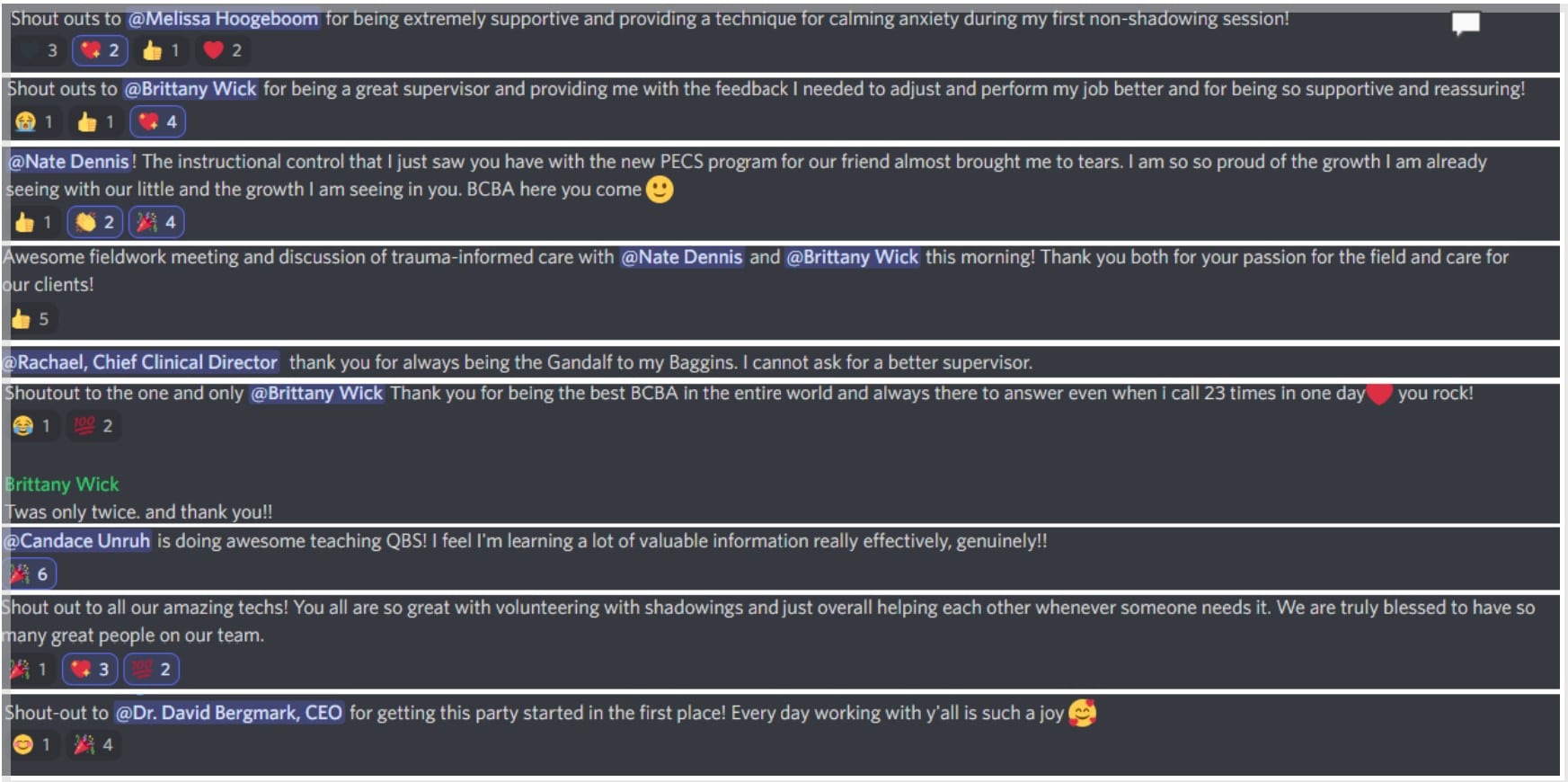How to Become an ABA Practitioner
There are so many ways to be involved in the field of behavior analysis! In a previous post (¿Qué hacen los terapeutas AAC?), I covered some of the general day-to-day activities of technicians and clinicians providing applied behavior analysis (ABA) services with autistic clients in clinical settings, along with a very brief overview of the requirements for becoming certified in those roles.
That information truly only scratched the surface, though. I hope that this post will help you consider whether ABA might be the right career path for you, and if so, help you to get started on that journey.

My Path to ABA
Personally, I stumbled into the science and practice of behavior analysis entirely by accident, and I feel so lucky to have done so. I knew that I wanted to be a professor and researcher one day, but was particularly interested in the science of learning itself. That, ultimately, is what behavior analysis is all about – helping people to learn in ways that are most effective for them.
Back then, there were very few bachelor’s degree programs covering behavior analysis in depth. I enrolled in a psychology program, and it just so happened to include an optional sequence of courses leading to a certificate in behavior analysis. After taking the first course at random, I was hooked for life. (Shout-out to my alma mater, Sacramento State University, and especially to my advisors Drs. Becky Penrod and Caio Miguel!)
As part of my degree program, I was encouraged to work as an ABA practitioner in order to apply what I was learning in the classroom. While I was completing my bachelor’s degree, I worked as a technician in-home with young autistic clients, an independent living services caregiver assisting adults with disabilities, and a counselor at an after-school camp for autistic youth. I also had the opportunity to practice basic research procedures with a rat lab and assist with research in teaching young children to diversify their diet when experiencing feeding disorders.
These hugely varied experiences proved to me early in my career just how effectively and flexibly the science of behavior analysis could be used in the world.
I went on to primarily work in schools from the elementary level all the way up to doctoral, but have also overseen research related to staff training, teaching exercises and dance moves, reaching fitness goals, practicing mindfulness, improving creativity, playing video games, and so much more. For the remainder of this post, I’ll be focusing on ABA in the context of clinical services, like those provided here at Waypoints – but the diversity of the field is what drew me to it initially.
Is the Field of ABA Right for You?
As I mentioned above, I knew that a career in ABA was a perfect fit for me because I was deeply interested in learning about learning, and I wanted to help people learn and achieve their goals. I most commonly hear from people working as ABA therapists, technicians, and clinicians that they got into this line of work out of sheer love for working with kids. (Though again, while our clients at Waypoints are primarily children and youth, that isn’t always the case in the field of ABA at large!)
No job is always fun and easy, though, and working as an ABA practitioner is no exception. Clinical roles sometimes involve helping clients to overcome challenging and dangerous behaviors, requiring that we remain calm, caring, and empathetic even in stressful and quickly-changing circumstances. We must always put our clients first during sessions, sometimes leading to our own emotional and physical exhaustion.
If you’re already having a rough day for other reasons, it can be undeniably difficult to stay positive and supportive – but it’s incredibly important to show clients that they can trust you even (and especially) when they’re stressed out or dysregulated.
In acknowledgement of the potential for burnout in this field, at Waypoints we offer no-questions-asked mental health days for employees, as well as an employee assistance program that includes free counseling sessions and other support services. As we hear every time we board a plane, it’s critical to put on your own mask first before assisting others.
Those are some of the main “risks,” but if ABA is the right field for you, it can be incredibly rewarding. At Waypoints and similar companies, working with autistic children and youth in their homes and communities, here are some traits that might make you a good fit for becoming an ABA practitioner:
- Above all, respect and care for the clients you work with
- Playfulness and a willingness to get silly
- Curiosity and eagerness to learn
- Joy from seeing others succeed and thrive
- A calm and soothing demeanor in stressful situations
- Independence, but also willingness to ask for help and guidance when needed
- Attention to detail when it comes to data collection and noticing what might be affecting behavior
- Appreciation for science and figuring out how and why things work
- Flexibility with scheduling and travel within your area
- Reliable time-management and organization
- Good communication skills, both face-to-face and via text message or email
- Ability to accept and apply critical feedback – from both supervisors and from clients directly! No one “tells it like it is” like a kid does.
This list was put together based on input from Waypoints employees, and there was a lot of overlap showing good consensus on these key qualities!
ABA Carreras
If that all sounds right up your alley, what are the next steps?
Great news – becoming a Registered Behavior Technician (RBT) requires no prior experience related to behavior analysis, and a large quantity of training is provided on-the-job. The BACB provides a handy infographic summarizing the requirements for getting certified as an RBT and, other than being 18 years of age and having a high school diploma or equivalent, all those requirements are fulfilled once you’ve already been hired.
Technicians working on becoming certified complete a minimum of 40 hours in training, as well as an initial competency assessment ensuring comfort and fluency with all the material on the RBT Task List. You can get a sneak peek at the first module of our own RBT training at Waypoints covering these requirements at this link!
RBTs are the absolute backbone of any ABA service provider, responsible for directly working with clients. Board Certified Behavior Analysts (BCBAs), meanwhile, are responsible for training and supervising RBTs, and also performing assessments, developing client programs, monitoring client progress, and making data-based decisions. The path to becoming a BCBA is quite a bit more intensive, requiring a master’s degree in behavior analysis, a minimum of 1500 hours of supervised fieldwork, and passing an exam with a 60% first-time pass rate.
There is often room for a lot of career growth between those two positions, though, and many RBTs don’t wish to become BCBAs in the first place. The responsibilities of the two roles are very different, and you may find that you prefer to continue working directly with clients as an ABA therapist or technician rather than ultimately becoming a clinician! RBTs may instead become lead technicians, taking on additional responsibilities for training and providing feedback to newer technicians, assisting with caregiver training and other transition services, or creating instructional materials for clients and staff alike.
It’s also possible to become a Qualified Behavioral Health Provider (QBHP) with a minimum of two years’ experience and a graduate degree, though the exact requirements vary state by state. In the field of ABA, QBHPs typically serve as behavior consultants in roles similar to BCBAs, but with more supervision and oversight of their work. This allows for a greater degree of collaboration and mentorship as one progresses through their career.
“The Registered Behavior Technician (RBT) is a paraprofessional certified in behavior analysis. RBTs assist in delivering behavior-analytic services and practice under the direction and close supervision of an RBT Supervisor and/or an RBT Requirements Coordinator, who are responsible for all work RBTs perform” (BACB, 2022, p. 4).
Common responsibilities include:
- Implementing skill acquisition and behavior reduction programs
- Collecting client data
- Graphing data
- Writing progress summaries and session notes
- Conducting preference assessments
- Assisting with functional assessments
- Communicating and collaborating effectively with clients, caregivers, and other professionals
ABA Careers at Waypoints
While this whole post has largely been from the perspective of working at Waypoints, I’d like to highlight a few specific perks we offer when it comes to starting a career in ABA as well. Even if you will be looking for a position elsewhere, these kinds of supports could be good to ask about during an interview with any company.
Firstly, all training time required for becoming an RBT is paid, including the 40 hours that need to be completed before working independently with clients can even begin. New employees receive a tablet to be used during client sessions, which can also be used for completion of onboarding trainings.
Similarly, employees pursuing BCBA certification are paid for all fieldwork hours related to training and client-specific programs, regardless of whether or not those hours are billable to insurance providers. No unpaid internships here!
We also provide a variety of materials to help with the certification process at both the RBT and BCBA levels, including flashcards and review quizzes, practice exams, video examples, and individualized resources and feedback. As the Director of Training, I personally meet with every employee as often as needed in order to discuss the training content until we’re both confident that they will pass their certification exam. So far, I’m proud to say that we have a 100% first-time pass rate.
In terms of continuing education, Waypoints provides stipends for full-time BCBAs to be used for maintaining certification requirements and professional development. In addition, online workshops are offered free of charge by both the Behavioral Health Center of Excellence (BHCOE) and our own employees. We also host a monthly journal club, encouraging discussion of new research and articles and how we can apply what we learn to our work with clients.
I really can’t say it better than Waypoints’ own employees – it may be trite, but we support and cheer each other on every day. You can get to know our awesome team at https://waypoints.life/our-team/.

If we’ve caught your eye and you’d like to learn more or apply for a position, visit us at https://waypoints.life/careers/!
Artículos relacionados

Building Meaningful Careers: Exploring Opportunities at Waypoints
Building Meaningful Careers: Exploring Opportunities at Waypoints One of our guiding principles at Waypoints is that the best client outcomes

Building Skills Through Positive Reinforcement
As I’ve written previously, ABA services can be especially helpful for learners who struggle in traditional academic settings. Many people

Optimizing the Learning Environment: How ABA Skill Building Can Benefit Autistic Children
Skill-building based on the principles of Applied Behavior Analysis (ABA) has the power to unlock any learner’s potential, and it
Póngase en contacto con Waypoints
Ya sea que esté buscando pruebas de diagnóstico, terapia AAC personalizada en el hogar y recursos para el desarrollo de habilidades, o simplemente desea obtener más información sobre nuestro enfoque único, ¡no dude en comunicarse con nosotros! (Nos encanta recibir correo).

